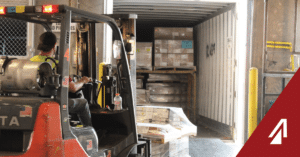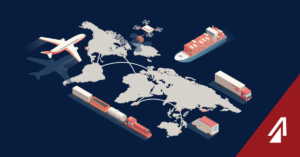Business operations have changed dramatically over the years – especially in regards to logistics. Before the modern internet age, operations like supply chains and logistics were necessary but were often treated like an isolated operation from the rest of product life cycle. Each individual operation in that cycle siloed its information from the other departments and worked independently. It got the job done but was not efficient.
Modern logistics does not and cannot act that way. There is too much at stake. According to a recent study, United States companies spent nearly $1.64 trillion in 2018 on their supply chain operations. With that much money on the line, not to mention the complexity of global operations and e-commerce, modern logistics providers cannot afford to operate in an outdated way. So, when you partner with a Logistic Service Provider (LSP), look for these three characteristics that mark a modern logistics provider.
Need a modern logistics provider to address your logistics needs?: LEARN MORE
Technologically Savvy
Modern supply chains move quickly, and customers expect better, more personalized service than before. In order to achieve this speed and level of service, your LSP needs to be technologically savvy. They should have the tools needed to capture the necessary data, interpret it, secure it, and share it with you and other necessary stakeholders. Some modern tools that should be in every LSP toolbox:
Cloud Computing
This is incredibly useful for data transmission and storage and is more secure than most onsite servers. In fact, according to Gartner, “Through 2020, public cloud infrastructure as a service (IaaS) workloads will suffer at least 60% fewer security incidents than those in traditional data centers.”
TMS
These are essential communication hubs for you to meet and exchange data with stakeholders like your LSP and others. They are also essential for data recording, reporting, and auditing.
AI
Artificial Intelligence has been a growing trend in the logistics industry. It is faster and more accurate than humans and can greatly reduce error rates. Many supply chain segments, like warehousing and distribution centers, are moving toward becoming fully automated operations with little to no human interaction.
EDI
This is a data transfer method that allows companies to transmit information automatically and securely without introducing outside errors.
IoT
Internet of Things devices have progressed rapidly since the early 2000s and now allow LSPs to capture and transmit more information than ever before. Nearly every supply chain operation can benefit from IoT from scanners in manufacturing, to GPS tracking your products in transit.
Blockchain
This is an emerging technology that can keep accurate and secure record of your transactions.
We’ve got advanced proprietary technology that can strengthen your supply chain: LEARN MORE
Quality Oriented
Not only should modern LSPs be up-to-date with their technology, they should strive to provide the best service possible through quality assurance and continued improvement. It is important to work with a provider that is aware of your goals and is actively striving to meet them. They should also show initiative to change if they do not meet your goals. They can take these initiatives in a few ways:
Aligned Goals
Your goals can be service, financial, sustainability, management, or otherwise focused, but it is important that your LSP share them. Modern LSPs act like an integrated segment of your supply chain and must work to strengthen, not weaken, it. They can act collaboratively – not selfishly – because they know that if you excel, so will they.
Quality Team
LSPs should have dedicated Quality Assurance teams, preferably green or black belts, that can pursue quality inquiries and lead corrective actions.
Quality Certifications
Certifications from 3rd parties, like ISO 9001:2015, prove your LSP is customer-focused and continually improving.
Continuous Improvement Initiatives
These can ongoing operations like process gridwalks or in-depth problem-solving methods like SIPOC.
Don’t get stuck on a plateau, continue saving and being more efficient: LEARN MORE
Resilient
Outdated supply chains relied on siloed companies and information and would often fail when disruptions occurred. Modern ones are resilient and rely on LSPs being strongly interconnected with other companies to get the job done – no matter what. A 2015 Accenture survey found that collaborating with suppliers saved companies 50% in supply chain time management 30% in potential cost savings. Some ways LSPs can exhibit resilience are:
Collaborative Relationships
These involve working with others in a win-win relationship. Each party benefits from the relationship and work with each other to both succeed.
Strong Carrier Network
Modern LSPs need to have strong tribal knowledge of the logistics industry and need to have strong carrier relationships. They should have capacity for available loads and should be able to get you a better price than the open market. They should also work well with their carriers to offer them benefits as well – such as favorable routes, rates, and payment schedules.
Strong Facility Network
LSPs today should have facilities where you need them to help you move your products faster. They should also have reliable facilities that can reduce the number of freight touches to help eliminate damage.
Each of these characteristics help make LSPs more effective. More importantly, they make you more effective. They help modern providers engage a fast-paced industry, improve service, and help you be more efficient.
We are ready to serve your needs with our strategic carrier / facility network: LEARN MORE



